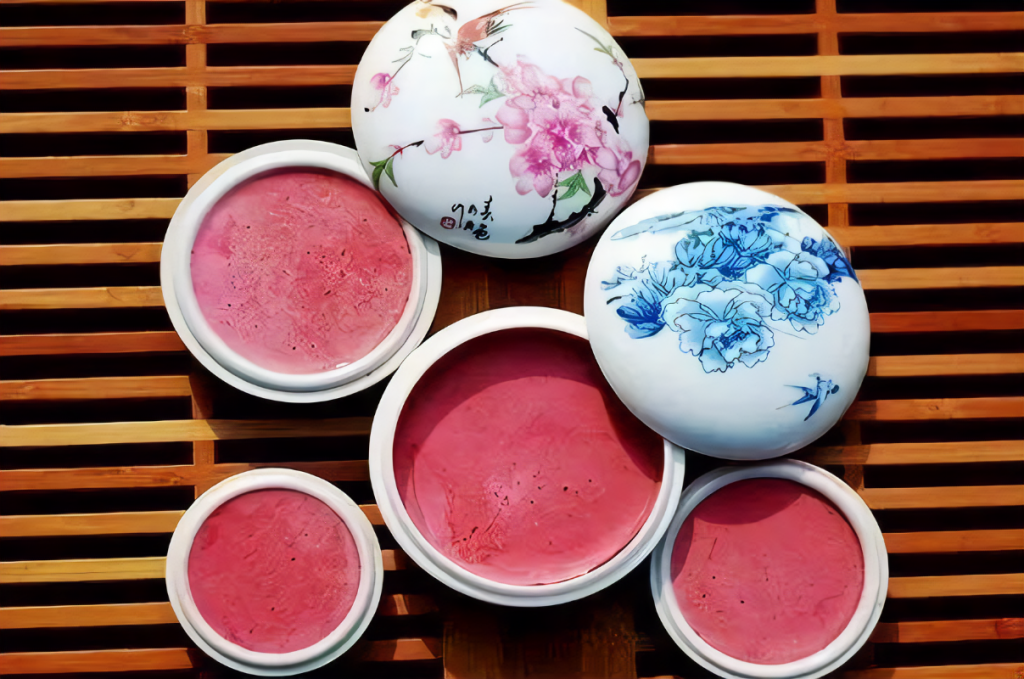Makeup has been an essential part of beauty routines for centuries, and ancient Chinese women were no exception. However, their cosmetic choices were not just about looking good—they were often a perilous mix of creativity and toxicity! From fermented rice powder to lead-based foundation, let’s dive into the fascinating yet frightening world of ancient Chinese cosmetics.
White as Snow: The Quest for Fair Skin
The desire for pale skin has long been a beauty standard in East Asia. Before modern foundations, ancient Chinese women used rice powder to achieve that perfect white complexion. The process, recorded in the Qi Min Yao Shu, involved grinding rice into a fine powder, washing it until the water ran clear, and fermenting it until it emitted a foul odor. This fermented rice was then dried, ground, and shaped into “powder cakes,” which were later crushed into fine powder for application.
However, rice powder had one major flaw—it easily rubbed off! Imagine a romantic moment ruined when a gentleman leans in for a kiss, only to find himself covered in white dust. To solve this problem, ancient Chinese women turned to a more long-lasting solution: white lead powder. This cosmetic upgrade ensured a smooth, flawless look that wouldn’t fade away during the day. But there was a deadly catch—lead is highly toxic. Prolonged use led to skin discoloration, illness, and even death. No wonder the phrase “washing away the lead” (from the idiom “washing away the lead powder”) came to symbolize removing artificial beauty and embracing one’s natural appearance.
Rouge and Lip Color: The Fiery Red Shades
Blush and lip color were also essential in ancient beauty routines. The earliest and most popular pigment was vermillion (朱砂, zhūshā), a brilliant red mineral made from cinnabar (mercury sulfide). Used as early as the Shang and Zhou dynasties, vermillion was applied as blush and lipstick by performers and palace women. But just like white lead, vermillion contained a deadly secret: mercury poisoning. Over time, it could cause severe neurological damage and other health issues.
To improve its texture and longevity, women mixed vermillion with animal fat, creating a substance remarkably similar to modern lipstick. By the Han dynasty, another popular red cosmetic, rouge (胭脂, yānzhī), had entered the scene. Some sources claim that it was introduced from the Xiongnu nomads and brought back to China by Zhang Qian during his travels to the Western Regions. Others argue that it had existed since the Shang dynasty, made from crushed safflower petals. Regardless of its origin, rouge became the dominant blush and lip color for centuries, symbolizing youth and vitality in literature and poetry.

Eyebrows on Fleek: The Art of Brow Shaping
A well-defined eyebrow was a must-have feature in ancient Chinese beauty. Women used black mineral powder (黛, dài), also known as “stone black,” which was ground on a special inkstone and mixed with water before being applied to the brows. Before the invention of mineral-based eyebrow color, women used charred willow branches to darken their brows, an ancient technique that surprisingly persisted until the 20th century.
The shape of eyebrows varied according to fashion trends. During the Tang dynasty, women favored long, curved brows, while in the Ming dynasty, thin, straight brows were in vogue. This artistic approach to eyebrows is reflected in poetry, with descriptions of “delicate willow-leaf brows” symbolizing elegance and refinement.
The Price of Beauty: A Deadly Trade-off
Beauty has always come at a cost, but in ancient China, that cost was often one’s health. From lead poisoning to mercury exposure, many women unknowingly risked their lives for a few moments of radiance. Some historical records even suggest that arsenic was used as a whitening agent—a truly horrifying thought!
Today, we have access to safe and scientifically tested cosmetics, but ancient beauty practices remain a fascinating part of history. They remind us of the lengths people have gone to in the pursuit of beauty, and how standards of attractiveness have evolved over time.
So next time you reach for your foundation or lipstick, take a moment to appreciate the toxin-free luxury of modern cosmetics!

No comments yet.